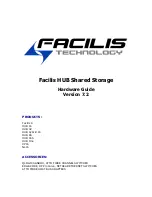
between sites using only the changed data from the Metro Mirror target to
the z/OS Global Mirror target after a GDPS HyperSwap.
z/OS Global Mirror Multiple Reader (enhanced readers)
z/OS Global Mirror Multiple Reader provides multiple Storage Device
Manager readers allowing improved throughput for remote mirroring
configurations in System z environments. z/OS Global Mirror Multiple
Reader helps maintain constant data consistency between mirrored sites
and promotes efficient recovery. This function is supported on the DS8000
series running in a System z environment with version 1.7 or later at no
additional charge.
Interoperability with existing and previous generations of the
DS8000 series
All of the remote mirroring solutions documented in the sections above use Fibre
Channel as the communications link between the primary and secondary storage
units. The Fibre Channel ports used for remote mirror and copy can be configured
as either a dedicated remote mirror link or as a shared port between remote
mirroring and Fibre Channel Protocol (FCP) data traffic.
The remote mirror and copy solutions are optional capabilities of the DS8800
Model 951 and are compatible with previous generations of DS8000. They are
available as follows:
v
Metro Mirror indicator feature numbers 75xx and 0744 and corresponding
DS8000 series function authorization (2396-LFA MM feature numbers 75xx)
v
Global Mirror indicator feature numbers 75xx and 0746 and corresponding
DS8000 series function authorization (2396-LFA GM feature numbers 75xx).
The DS8000 series systems can also participate in Global Copy solutions with the
IBM TotalStorage ESS Model 750, IBM TotalStorage ESS Model 800, and IBM
System Storage DS6000 series systems for data migration. For more information on
data migration and migration services, contact IBM or a Business Partner
representative.
Global Copy is a non-synchronous long distance copy option for data migration
and backup, and is available under Metro Mirror and Global Mirror licenses or
Remote Mirror and Copy license on older DS8000, ESS, or DS6000 systems.
Thin provisioned and Global Mirror volume considerations
This section discusses thin provisioned and Global Mirror volume considerations.
The time it takes to recover from a consistent Global Mirror copy, after a planned
or unplanned disaster recovery swap, depends on the configured size of volumes
that need to be recovered using the FlashCopy Fast Reverse Restore (FRR) option.
The larger the total logical size of volumes, the longer the total recovery time.
For thin provisioned volumes, the time to recover from a Global Mirror copy is
related to the total logical size of the volumes, regardless of the actual provisioned
space. For example, if the space over-provisioned is a ratio of 2 to 1, the recovery
time is equivalent to the recovery for twice the configuration of fully provisioned
volumes. The larger the logical configuration (regardless of how much storage is
actually provisioned), the proportionally longer the recovery commands take to
complete. This might cause the commands to timeout, causing failures in the
recovery process.
Chapter 3. Data management features
63
Summary of Contents for DS8700
Page 2: ......
Page 8: ...vi Introduction and Planning Guide...
Page 10: ...viii Introduction and Planning Guide...
Page 20: ...xviii Introduction and Planning Guide...
Page 22: ...xx Introduction and Planning Guide...
Page 44: ...22 Introduction and Planning Guide...
Page 142: ...120 Introduction and Planning Guide...
Page 160: ...138 Introduction and Planning Guide...
Page 212: ...190 Introduction and Planning Guide...
Page 218: ...196 Introduction and Planning Guide...
Page 224: ...202 Introduction and Planning Guide...
Page 242: ...220 Introduction and Planning Guide...
Page 254: ...232 Introduction and Planning Guide...
Page 255: ......
Page 256: ...Printed in USA GC27 2297 09...
















































